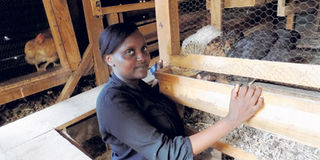From storey chicken house to bag farming, your tiny plot can give you a lot

Sarah Itambo in her storey poultry house in Donholm, Nairobi. RACHEL KIBUI
What you need to know:
- She holds a Diploma in Tourism from Railway Training Institute, but has instead established herself in urban farming, complete with training both locally and internationally.
- To further utilise the space, Sarah has a six-floor structure behind the house where she rears chickens and rabbits.
- Sarah says she has been hosting visitors from as far as US, Canada, India, Dubai, Sierra Leone and nearby Tanzania, and her visitor’s book attest to this.
Donholm estate in Nairobi is characterised by neatly arranged storey houses. On this day, the atmosphere is quiet and gates locked, with only a few people walking around.
We stop at a grey gate, knock and wait for about three minutes before we are ushered in. On the left are two tanks. Being in Nairobi, one would assume that the tanks are for water storage. After all, in this estate, like many others in the city, water shortage is a common phenomenon.
But that is until Sarah Itambo, 27, pours into the tanks some fish meal. A number of catfish jump up, introducing us to a thriving agribusiness.
“This is my aquaponics system and there are 500 catfish in the tanks,” says Sarah, of her business venture which she has squeezed in front of her parents’ house. It is from here that she makes her money, one fish at a time. A kilo goes for Sh400.
“I usually make more when I do value addition; like when I cook before selling,” she offers.
To get a picture of how tiny the space is, Sarah informs us that the plot measures only 22 by 75 feet, with three quarter of the space being occupied by the family’s four-bedroom house.
The ponds are wrapped neatly with a polythene paper, the kind that is used in constructing greenhouses. Reason? “Catfish thrive in warm temperatures,” explains Sarah.
Still, on top of the aquaponics system, are two trays, each with collard green (sukuma wiki) seedlings. This is her other source of income. She sells each seedling at Sh2 each.
SIX-FLOOR STRUCTURE
To further utilise the space, Sarah has a six-floor structure behind the house where she rears chickens and rabbits.
“The three levels below used to host up to 300 rabbits, at that time I was a breeder. But I sold them all. I am strategising on how to bounce back on that front,” she says.
We take the stairs and above the rabbit cages are the poultry pens, in three levels that can house up to 300 chickens.
For now though, Sarah has only 50, having sold most of her chickens. She rears a cross breed of kienyeji and Kenbro.
“The cages have wire mesh floors. So the droppings go right under on a surface on which I sprinkle saw dust each time I clean,” she explains.
The saw dust absorbs moisture and ammonium from the droppings, therefore keeping the pens dry and smell at bay for up to three months.
Had she not applied this technique, she would have risked being barred from farming by the city government officials for air pollution, which is against the Urban and Peri-Urban Farmers Policy.
Before she explains further, a hotelier at a shopping centre in the estate calls, ordering for pumpkin leaves, a traditional vegetable. It is this call that takes us to yet another section where she grows pumpkins in a green house. One can’t help admiring her grasp of the best agricultural practices and as she goes about explaining what the Urban and Peri-Urban Farming Policy entails, one would easily think she has a high-level degree in agriculture.
But no. She holds a Diploma in Tourism from Railway Training Institute, but has instead established herself in urban farming, complete with training both locally and internationally.
“I have gathered most of my knowledge by attending trainings and conferences on farming,” she explains.
In 2013, she was in Canada for three weeks where she learnt among other things rooftop farming, community agriculture, spin farming (from ‘small plot intensive’) and visited several urban farms.
Today, Sarah is not only a farmer, but also trains farmers for Sh1,500 per person while just a farm visit costs Sh1,000.
She charges 10 to 16 per cent of the total cost of materials needed to establish an aquaponics system, hanging gardens, green houses, poultry and rabbit cages.
In a good month, she makes more than Sh100,000 from the farm, trainings and farm establishment.
Sarah’s passion started when she was only six, when her family moved to this estate.
During the school holidays, her parents, who were then working in the city – her father as an engineer and her mother an accountant – would assign each of their six children a small piece of land to plant vegetables.
Though the youngest, Sarah’s plot would always emerge the best, earning her praise and gifts especially from her mother.
Says she, “I just used to be fascinated by the fact that I could plant seeds and they would sprout after a while, little did I know that the ‘mini shamba” would end up as my office.”
Fast forward to 2008 after she had graduated from college and did not feel like working for a tour company.
“Mum and I borrowed Sh150,000 and Sh100,000 respectively from the Kenya Women Enterprise Fund and started commercial chicken and rabbit farming,” she says proudly.
She started by developing a crossbreed of indigenous chicken and Kenbro, that would lay and hatch. She was able to achieve her target in the fifth generation. She would get chicken of up to 6kg, which she easily got ready market for within the neighbourhood at between Sh1,500 and Sh2,500 each.
She also would supply eggs to nearby supermarkets.
“But I now have about 50 layers producing between 25 to 30 eggs daily. Production is low due to the current cold weather. I have learnt that during cold weather, hens spend a lot of energy generating heat to warm up the body, thus the low production,” she adds.
HOSTING VISITORS
Sarah says she has been hosting visitors from as far as US, Canada, India, Dubai, Sierra Leone and nearby Tanzania, and her visitor’s book attest to this.
Her mother, Evelyne Wamuyu, has no regrets for introducing her children to agriculture at a tender age.
“I always noticed that the she was interested most in farming and I nurtured the passion,” she says, adding, “Now she keeps my husband and I busy as we have already retired.”
Evelyne adds that it would have been extremely boring for her and the husband spending days in the house, but now they are the helping hands to their daughter, thus, she does not need any employees.
To market her produce and services, Sarah has a Facebook page ‘Smart Urban Farm Technologies’. She also sells on free online classified ads, uses word of mouth and a banner at the estate’s main gate.
But it has not been all glamour for her journey in farming.
At one time, desperate to clear a family loan, she fell in the hands of a cunning broker.
“He took away more than 200 chicken and promised to pay after a few days only to pay half the amount,” she says.
No space, not even in the highest of city suburbs, is too small for farming, if only people are driven by passion, according to experts.
Geoffrey Kahuho, a programmes officer at Participatory Ecological Land Use Management (Pelum), Kenya says people in urban areas must not depend on rural areas for food.
“Even rooftop farming works wonders and the small tanks that can host a few fish can nurture an agricultural entrepreneur of the future,” says Kahuho.
He encourages parents in urban areas to introduce farming skills to their children as a way of nurturing talent and passion.
He, however, asks urban farmers to take measures against pollution.





